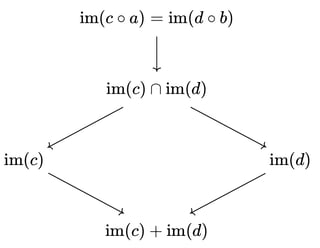$\newcommand{\im}{\operatorname{Im}}$Consider the following (subpart of) a double complex, using the same notation as in George Bergman's pre-print or in these lecture notes:
$$\require{AMScd}\begin{CD} \bullet @>a>> \bullet @>>> \bullet \\ @VbVV @VcVV @VVV \\ \bullet @>d>> A @>e>> \bullet \\ @VVV @VfVV @VgVV \\ \bullet @>>> \bullet @>h>> \bullet \end{CD} $$
and define $p = c\circ a = d\circ b$ (diagonal into $A$), $q= g \circ e = h \circ f$ (diagonal out of $A$).
Question: What "information" is contained in the modules $\dfrac{\ker (q)}{\ker (e) + \ker(f)}$ and $\dfrac{\im(c) \cap \im(d)}{\im(p)}$ which is interesting/is useful/we care about?
Here is what I believe to be an equivalent question:
Question: (i) Why is the donor of $A$ defined as $\dfrac{\ker (q)}{\im(c) + \im(d)}$ instead of $\dfrac{\ker(e) + \ker(f)}{\im(c) + \im(d)}$?
(ii) Why is the receptor of $A$ defined as $\dfrac{\ker(e) \cap\ker(f)}{\im (p)}$ instead of $\dfrac{\ker(e) \cap \ker(f)}{\im(c) \cap \im(d)}$?
(Probably unnecessary) Background: Since one has that $\im (\psi \circ \phi) \subseteq \im(\psi)$ and $\ker(phi) \subseteq \ker(\psi \circ \phi)$ for any morphisms $\psi, \phi$, one always has the chains of inclusion: $$ \im(p) \subseteq \im(c) \cap \im(d) \subseteq \ker(e) \cap \ker(f) $$ and $$ \im(c) + \im(d) \subseteq \ker(e) + \ker(f) \subseteq \ker(q)$$ (since of course that it's a double complex means that $\im(c) \subseteq \ker(f)$ and $\im(d) \subseteq \ker(e)$).
Denote by $D = D_1/D_2$ (with $D_1 \subseteq A \supseteq D_2$) a "candidate donor" and $R = R_1 /R_2$ (with $R_1 \subseteq A \supseteq R_2$) a "candidate receptor". Denote by $A^v$ the vertical homology $\ker (f) / \im(c)$ and denote by $A^h$ the horizontal homology $\ker(e) / \im(d)$. Then consider the following properties we want to be satisfied by any candidate donor or receptor.
Intramural properties: (Compare Lemma 1.2 or Lemma 2.)
- Inclusion $R_1 \to \ker(f)$ and $R_1 \to \ker(e)$ should induce morphisms $R \to A^v$ and $R \to A^h$.
- Inclusion $\ker(f)\! \to D_1$ and $\ker(e) \to D_1$ should induce morphisms $A^v \to D$ and $A^h \to D.$
Extramural Properties: (Compare Lemma 1.4 or Lemma 3.)
Letting $D_{(A)}$ denote the (candidate) donor of $A$, and analogously $R_{(B)}$ the (candidate) receptor of $B$, then a morphism (horizontal or vertical) in the double complex $A \to B$ should induce a morphism $D_{(A)} \to R_{(B)}$. (According to George Bergman's pre-print this property is the source of/motivation for the names "donor" and "receptor".)
Assuming I am not making any overly stupid errors, the intramural properties should require (compare the comment in Anton Geraschenko's blog post) that:
- $\{0\} \subseteq R_1 \subseteq \ker(e) \cap \ker(f)$.
- $\{0\} \subseteq R_2 \subseteq \im(c) \cap \im(d)$.
- $\ker(e) + \ker(f) \subseteq D_1 \subseteq A$.
- $\im(c) + \im(d) \subseteq D_2 \subseteq A$.
Moreover, the obvious requirements that $R_2 \subseteq R_1$ and $D_2 \subseteq D_1$ suggest we want $R_1$ as large as possible and $D_2$ as small as possible, since the "upper bounds" for $R_1$ and $R_2$ will coincide when the complex is exact at $A$ horizontally and vertically (and similarly the "lower bounds" for $D_1$ and $D_2$ will also coincide when the complex is exact at $A$ horizontally and vertically).
So as far as I can tell, and obviously the above argument is very heuristic:
- any candidate donor $D$ should be of the form $\dfrac{D_1}{\im (c) + \im (d)}$.
- any candidate receptor $R$ should be of the form $\dfrac{\ker(e) \cap \ker(f)}{R_2}$.
Now, again barring any stupid algebra mistakes, it seems that any of the possible choices:
- $\ker(e) + \ker(f) \subseteq D_1 \subseteq A$,
- $\{0\} \subseteq R_2 \subseteq \im(c) \cap \im(d)$,
will (at least given the choices made for $D_2$ and $R_1$ above) satisfy the extramural properties due to the fact that it's a double complex and any two consecutive arrows equal the $0$ morphism.
So it's very unclear to me why one should prefer one of these choices of $D_1$ or $R_2$ to any other possible choice. As an arbitrary thing, it seemed like (since the choices of $A$ and $\{0\}$ seem to be very boring), the simplest thing would be to choose the smallest possible $D_1$ and the largest possible $R_2$, thus $D_1 = \ker(e) + \ker(f)$ and $R_2 = \im(c) \cap \im(d)$.
But apparently the correct thing to do is to choose $D_1 = \ker(q)$ and $R_2 = \im(p)$, and I can't figure out why. Why do we care about the "information" in $\ker(q) / (\ker(e) + \ker(f) )$ but not about the information in $A / \ker(q)$, such that we're not willing to discard the former but are willing to discard the latter? Similarly, why do we care about the information in $(\im(c) \cap \im(d))/\im (p)$, but not about the information in $\im(p)$, such that we're not willing to discard the former but willing to discard the latter? It seems like there must be another property of the donor/receptor which I am overlooking in order for this to be unclear to me.


